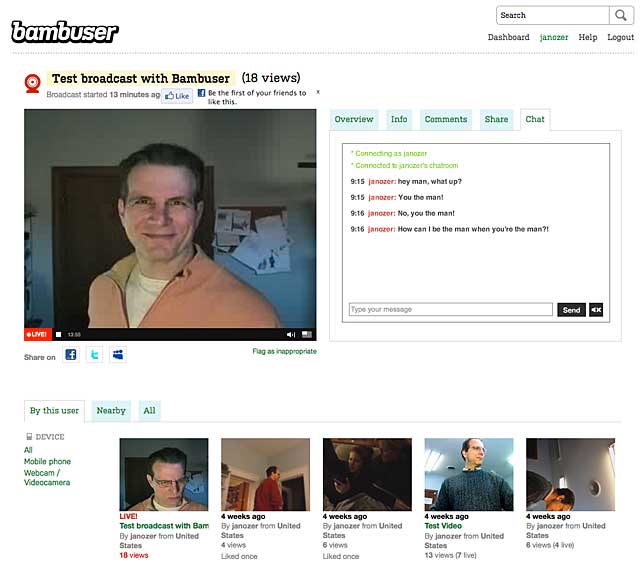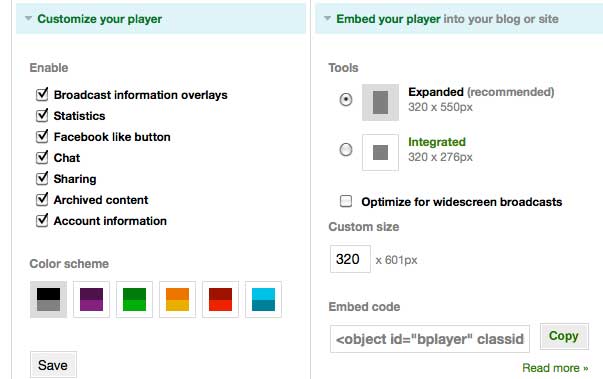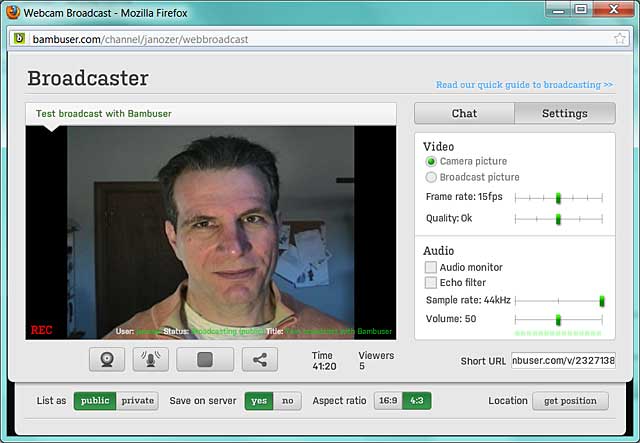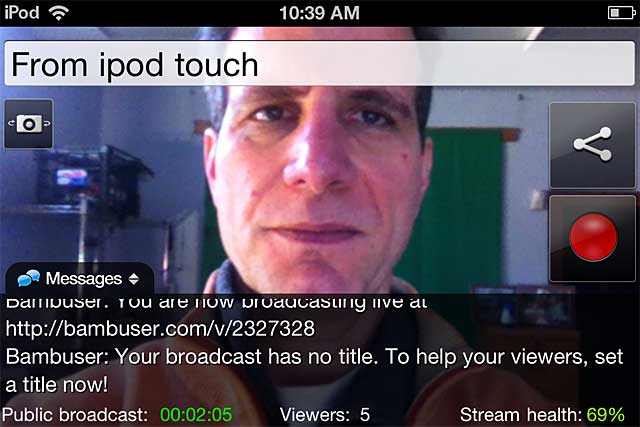Bambuser Review: A Simple Live Streaming Interface, but No Frills
This is part two of our four-part series reviewing the live streaming services. Read the introduction and Livestream review.
Bambuser's strengths include overall ease of use, support for over 300 mobile devices for broadcasting and playback, the ability to deliver multiple video streams, and a compact embedded player. On the other hand, Bambuser lacks the traffic offered by Ustream, Justing.tv, and Livestream, making it a bad choice if you're hoping your live streaming service provider (LSSP) can direct eyeballs to your videos, and Bambuser generally offers fewer features than these other sites.
Bambuser's channel page is plain and non-configurable, but functional. The default view is a world map that shows the location of the broadcaster, which is unique and kind of fun. Other tabs show basic site information like location and owner, comments from viewers, and sharing functions, which includes posting a link to Facebook, Twitter, and several other services, as well as chat. The channel page also provides access to all archived videos, plus live videos from other Bambuser broadcasters.
Bambuser's access control is especially limited: videos are either public, letting anyone watch them, or private, where only you can watch them, but there's nothing in between. Other sites offer the ability to password protect videos, a useful option. Other sites also offer more established programs for pay-per-view and subscription offerings, so Bambuser shouldn't be your top choice if you're seeking to monetize your video.

Figure 1. Bambuser's channel page.
Bambuser's embedded player is compact and competent, packing a relevant range of features into a tight space that will fit neatly into a web page. You can customize the size to your liking, and choose whether or not to include features like a Facebook Like button, sharing options, access to archived content, and basic account information. A preview mode makes it easy to see which options you're selecting.

Figure 2. Bambusers' embedding options.
However, Bambuser doesn't offer advanced features like Ustream's extensions, or the ability to schedule broadcasts. Bambuser also can't match features like accessing Facebook and Twitter chat during your broadcasts, which several other services offer, and it can't embed a player in Facebook so that video is played there; you can only provide a link within Facebook.
Broadcasting with Bambuser
Bambuser's browser-based broadcast console is easy to use, but lacks features like the ability to specify an outbound audio and video data rate, which is essential for smooth live streaming performance. As you can see in Figure 3, you also have volume control, frame rate control, and access to chat, as well as sharing options.

Figure 3. Bambuser's web-based broadcast module.
The embedded player worked well during playback on my desktop computer and Toshiba Thrive, but the Flash drive player didn't appear on my iPad or iPod Touch, though Bambuser should offer HTML5 embed codes soon. The videos did play on my iOS devices from the channel page on Bambuser. On all platforms, the video played with minimal latency, but video quality was marred by faint blockiness throughout, which I saw in all video created using the Flash Player-based browser encoder.

Figure 4. Bambuser's compact and efficient embedded player.
Seeking improved quality, I went to Bambuser's channel page, which has clear instructions for working with third party tools like the Adobe Flash Media Live Encoder (FMLE) and Telestream Wirecast. Specifically, you can download an XML file from your channel page to import into these tools that provides all the necessary login credentials and server addresses. After that, it's business as usual; choose your audio and video sources and start the broadcast.
Video quality was noticeably better using the H.264 codec available in both Wirecast and FMLE, plus you get much more precise controls for audio and video bandwidth. If you choose Bambuser as your live streaming service provider, you should definitely consider using one of these third-party services.
Since one of Bambuser's key strengths is mobile-based broadcasting, I ran some quick tests using the company's iPhone/iPod Touch app. Once I downloaded the free app and logged in, broadcasting was simple. Unlike most other services, if you're broadcasting over bandwidth-limited pipes, Bambuser captures the video on your mobile device at full quality and can upload the higher quality file after the broadcast is complete. That way, you have a high quality version to serve as your on-demand file.

Figure 5. Broadcasting from Bambuser's mobile player was simple.
On the other hand, Bambuser lacked features like polling and chat that were available on Ustream's iPhone app, though how you could shoot video on an iPhone and chat at the same time is beyond me (you probably need to be a teenager to accomplish that).
Consider Bambuser for your live broadcasts if you need extensive mobile support, which Bambuser lists at http://bambuser.com/phones. It's also a good choice for those looking for overall ease of use, since the relative lack of features does translate into a cleaner interface with less options. Avoid Bambuser if you're seeking eyeballs or established programs for video monetization.
Related Articles
For those streaming live video to a younger audience, Justin.tv is a top choice. It's easy to use, but doesn't stream to Apple iOS devices without a paid app.
23 Feb 2012
Part one of our four-part series on live video streaming services: While lacking some e-commerce tools offered by competitors, Livestream is still a top contender. Plus: a video preview of Livestream changes.
21 Feb 2012